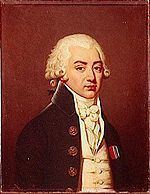Allegiance France Coronation date 1788 | Role Politician Name Armand de Deposed date December 31, 1793 | |
 | ||
Born 13 April 1747Paris ( 1747-04-13 ) Awards Society of the Cincinnati, Order of Saint Louis Similar People Jean Baptiste Camille C, Adam Philippe - Comte de, Francois Severin Marceau‑Desgraviers, Jean Baptiste Kleber, Francois de Charette | ||
Armand Louis de Gontaut, Duc de Lauzun, later duc de Biron, and usually referred to by historians of the French Revolution simply as Biron (13 April 1747 – 31 December 1793) was a French soldier and politician, known for the part he played in the American War of Independence and the French Revolutionary Wars. In 1773, he was Grand second warden of Grand Orient de France.
Contents

Early life
Born in Paris, he bore the title of Duc de Lauzun, which had passed, on the death of Antoine Nompar de Caumont, duc de Lauzun (1633–1723), to his niece, the wife of Charles Armand de Gontaut, duc de Biron (1663–1756). In 1788, he succeeded to the duchy of Biron on the death of his uncle, Louis Antoine de Gontaut, duc de Biron (1700–1788). He married Amelia de Boufflers, only daughter of Charles-Joseph de Boufflers (1731–1751) and Mary Anne Philippine de Montmorency Logny (1732–1797), a young woman described as a paragon a gentle, virginal shyness, a combination of shrewdness and simplicity. Similarly the Duke was a popular companion and house guest.
American Revolution service
After, for a while, spending his fortune in various parts of Europe, he attracted attention by an essay on the military defences of Great Britain and her colonial empire (État de defense d'Angleterre et de toutes ses possessions dans les quatres parties du monde). This led to his appointment to a command against the British in 1779. In February he commanded the troops that captured Fort St Louis, in Senegal, from the British. After raising an army of volunteer hussars and infantry, subsequently known as Lauzun's Legion, for service in North America. He arrived with 600 of his men in Rhode Island; the remainder were in France, prevented from leaving. Despite having only a portion of his force, he engaged in several active skirmishes, including one near Gloucester, Virginia on 4 October 1781.
In 1781, he took an important part in the American War of Independence by being the advance party of the main French army of Rochambeau sent to reinforce General George Washington at the Siege of Yorktown in 1781. Lauzun's Legion left their winter quarters in Lebanon, Connecticut on 9 June 1781 and marched south through Connecticut known as the Washington-Rochambeau Revolutionary Route. Their main function was to be an advance party but also to remain ten to fifteen miles south of the main army to protect the flank against any British located in the many Tory towns in lower Fairfield County. While in Connecticut, the French made camps in Middletown, Wallingford, North Haven, Ripton and North Stratford. They arrived at North Stratford, now Nichols on 28 June and stayed for two days. From the hilltop in North Stratford, now Abraham Nichols Park, one could easily see for seventy miles past Long Island Sound to New York and beyond. The French used this time to spy on British ships in New York harbor. After the successful campaign at Yorktown and subsequent British surrender, Lauzun returned to France a hero and was made maréchal de camp.
French Revolution service
In 1789, he was returned as deputy to the Estates-General by the noblesse of Quercy, and affiliated with the Revolutionary cause. In 1791, he was sent by the National Constituent Assembly to receive the oath of the army of Flanders, and subsequently was appointed to its command. In July 1792, on the wake of the revolutionary conflict, he was named commander of the Army of the Rhine, with the duty of watching the movements of the Habsburg Monarchy troops.
In May 1793, he was transferred to the command of the French Revolutionary Army on the La Rochelle front, operating against the Vendéan insurgency. He gained several successes, among them the capture of Saumur and the victory of Parthenay, but the insubordination of his troops and the suspicions of his political supervisors made his position intolerable and he sent in his resignation.
Execution
He was accused by the notorious Jean-Baptiste Carrier of incivisme ("lack of civic virtue", the equivalent of treason under the Reign of Terror) and undue leniency to the insurgents, deprived of his command (July), imprisoned in the Abbaye, sentenced to death by the Revolutionary Tribunal and guillotined. His wife, Amélie de Boufflers, was herself executed on 27 June 1794.
Works
His Memoires, which come down to 1783, were published under his name in 1822 (and reprinted in a new edition of 1858), and letters were published in 1865, said to have been written by him in 1789 to friends in the country, describing the Estates-General.
